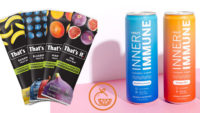2018 Predictions: Probiotics
Probiotics Megatrend
While 2017 could easily have been called the "Year of Gut Health," 2018 promises to see that focus intensify

Better for the belly. More consumers recognize the connection between digestive health and overall wellness.
SOURCE: NEXT FOODS INC. (WWW.GOODBELLY.COM)
This fall, it was announced in Genetic Engineering and Biotechnology News that researchers were able to create a 3D map of the gut microbiome. The study, published in the Proceedings of the National Academy of Sciences, allowed the researchers to “see exactly how the bacteria were arranged relative to each other and relative to landmarks like food and host tissue.”
“[I]t is not enough to know just which microbes are present,” explained Gary Borisy, PhD, one of the senior research investigators. “We must also learn what they are doing, who they are ‘talking’ to, and why. Part of the answer to that problem is to figure out who is next to who and who is next to what.”
It is this type of research that is driving into the next year and beyond what unequivocally has been the biggest ingredient trend in better-for-you foods and beverages: probiotics and the prebiotics that feed them. While 2017 could easily have been called the “Year of Gut Health,” 2018 promises to see that focus intensify.
“What is most telling is the science,” says George Paraskevakos, executive director of the International Probiotics Association. “We have gone from maybe 500 published articles, studies, technical papers, and other research [on probiotics] to a time when a quick search on PubMed will yield...15,000 different published materials.” Half of those studies were published just in the past five years. Add in prebiotics, and the number of studies listed surpasses 25,000.
Whereas research once was focused primarily on gastrointestinal health, it has expanded markedly into the brain/gut axis, metabolic syndrome, cardiovascular health, cholesterol, obesity, diabetes, immunity, oral health, skin disorders, and women’s health.
“I also believe there is ongoing research that one day we will see probiotics addressing health outcomes for disease states—it is [only] a question of time,” Paraskevakos adds.
In an annual trends report on what’s “new and emerging in natural and organic foods,” the Sterling-Rice Group (SRG) focused on the product innovations driving the probiotics “megatrend.” According to the Group’s research, at least three factors are contributing toward rapid growth in probiotic offerings: “continued consumer interest in foods and beverages with optimal nutritional benefits; heightened and growing awareness of the correlation between digestive health and overall health; and new science driving shelf-stable snacking innovations and reinforcing product claims.”
Based on data compiled by SRG, the US probiotics segment “is expected to continue to grow at double-digit rates annually.” The total global market, now well above $41 billion annually, is projected to hit $75 billion by 2025.
SRG identified the top nine product innovations in the probiotic space—eight food and beverage products and a topical skin care product. This “Natural Nine” included probiotics-infused coconut water; a crispy, shelf-stable sauerkraut snack chip; “live” probiotic sriracha sauce in both green and red chili pepper formats; probiotic-dusted “superfood” popcorn (in a tandoori-turmeric flavor and including “adaptogens”); probiotic ice cream; dairy-free, no-sugar-added probiotic juices; probiotic chewing gum; and even new packaging technology that “allows consumers to activate prebiotic and probiotics with the simple push of the finger.”
“While the probiotic category has been hot for several years, we are now seeing the right confluence of consumer awareness, R&D, and category investment to drive unprecedented growth,” notes Liz Moskow, SRG culinary director.
Article compiled by Sterling-Rice Group and Prepared Foods. Details of the SRG report, as well as the full list of its Natural Nine for 2017 can be found at: bit.ly/2eHR9ED or at www.srg.com.
Originally appeared in the December, 2017 issue of Prepared Foods as Probiotics Megatrend.
Looking for a reprint of this article?
From high-res PDFs to custom plaques, order your copy today!





